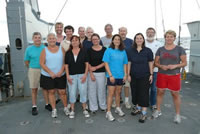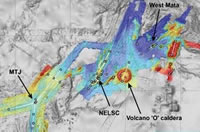2008 Expedition to Lau Basin
November 27, 2008
Here we are on Thanksgiving Day, conducting our final water-column casts before starting our 16-hour drive into port in Apia, Western Samoa. This has been an interesting and productive expedition. All of the exploration work on this trip has been done within the waters of the Kingdom of Tonga. We began our work on the Mangatolo Triple Junction (MTJ, also called the Kings Triple Junction) in the western part of our survey area. A triple junction is an unusual feature where 3 different spreading plate boundaries come together at one point. In this case our plume surveys indicated that only the northern arm of the MTJ currently has strong hydrothermal activity. Then we moved to the west and began working on the Northeastern Lau Spreading Center (NELSC), which proved to be much more interesting. As described in our Nov. 21 blog entry, one of our first surveys along the NELSC detected a remarkable layering of plumes extending up to 600 meters above the seafloor. Since typical hydrothermal plumes rise less than 300 meters above the ocean floor, these high rising plumes had us puzzled. Furthermore, some of these plume layers contained very high concentrations of hydrogen gas, which suggested to us that a seafloor volcanic eruption was either occurring or had recently occurred. What was even more surprising was that we were not able to find these high rising plumes during later surveys over the same area. We finally decided we were dealing with a system that was constantly changing, instead of the usual steady input from a long-lived hot spring system. This is exactly what one would expect from a seafloor volcanic eruption.
After completing an initial survey of the NELSC, we adopted a strategy of making “sorties” to survey areas to the east and north, and then returning to the NELSC to re-sample the area of the purported seafloor eruption. Directly east of the NELSC the seafloor is dominated by an impressive circular volcanic caldera named Volcano “O”. Backscatter data acquired during our bathymetric surveys showed that Volcano O is the source of several lava flows covering large areas of the seafloor. Our plume surveys showed that Volcano O is also host to several active hydrothermal vents.
When we embarked on this expedition, we expected that we would be locating sites of steady hot spring activity, not areas affected by seafloor eruptions. Not only did we find indications of eruptive activity at one site on the NELSC, during that latter part of the expedition we encountered a second actively erupting site on the summit of a volcanic cone. As described in our Nov. 25 blog entry, a CTD cast over the summit of West Mata volcano encountered thick particle plumes with excess temperature up to 2 deg C and high concentrations of hydrogen gas. Although the West Mata plumes were close to the volcano summit, they had all the characteristics normally associated with active lava flows. Thus it appears that we found two regions of seafloor eruptive activity during our expedition.
Now all that remains is to pack up our gear and our samples, ship them back to our respective laboratories in Seattle and Newport, and begin additional measurements on these samples. These shore-based measurements should allow us to draw more definite conclusions concerning the origin of the diverse water-column plumes we encountered on this expedition.
John Lupton, Chief Scientist
updated 1/14/2009


